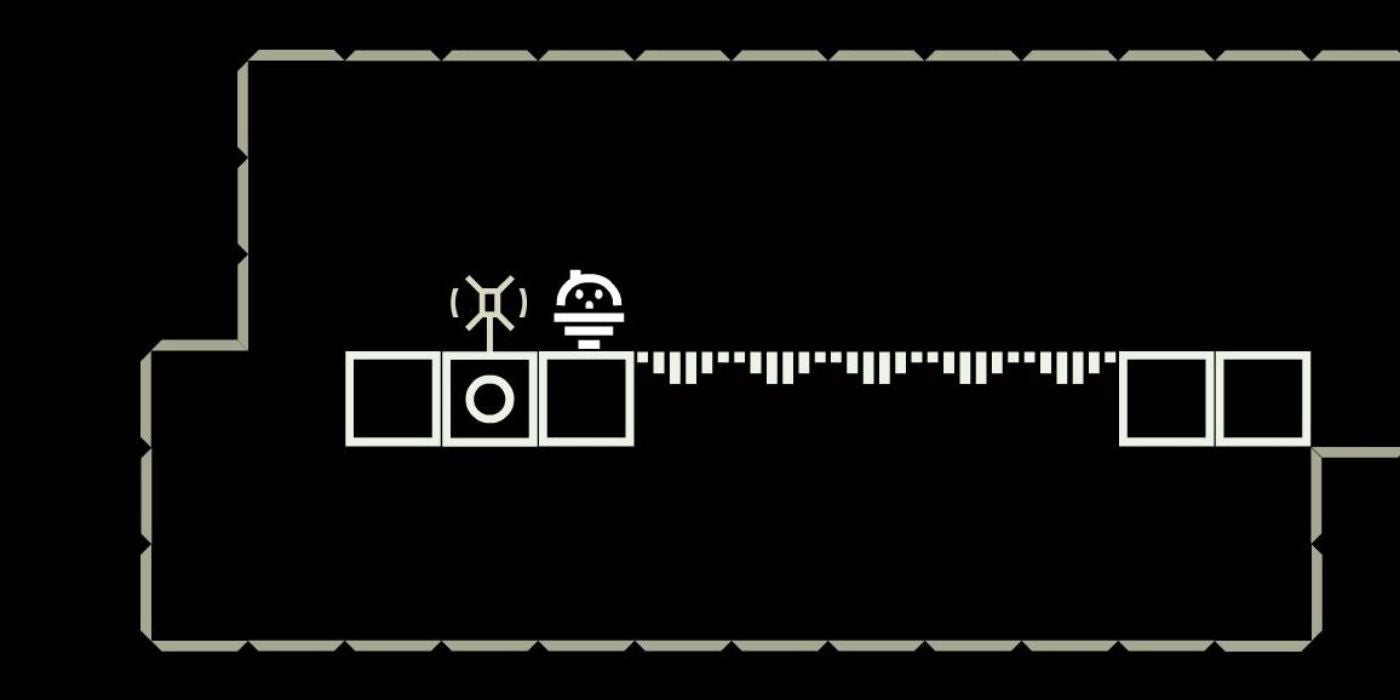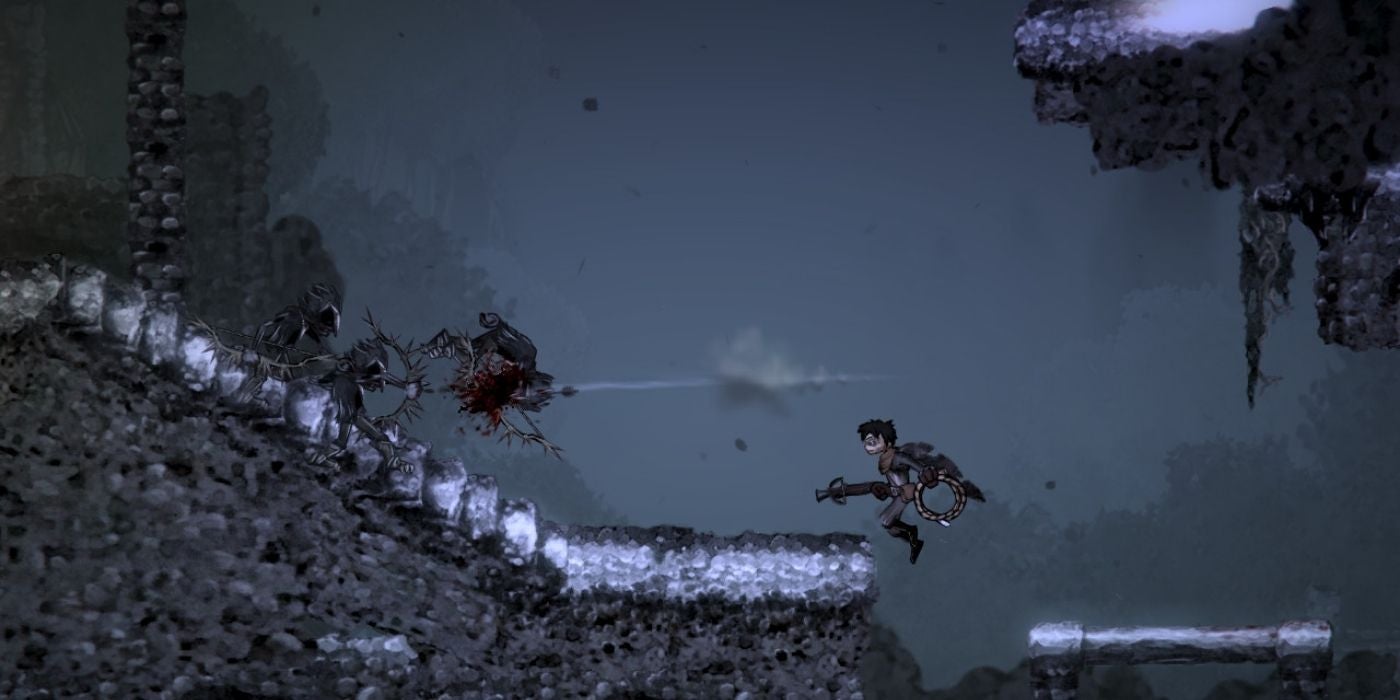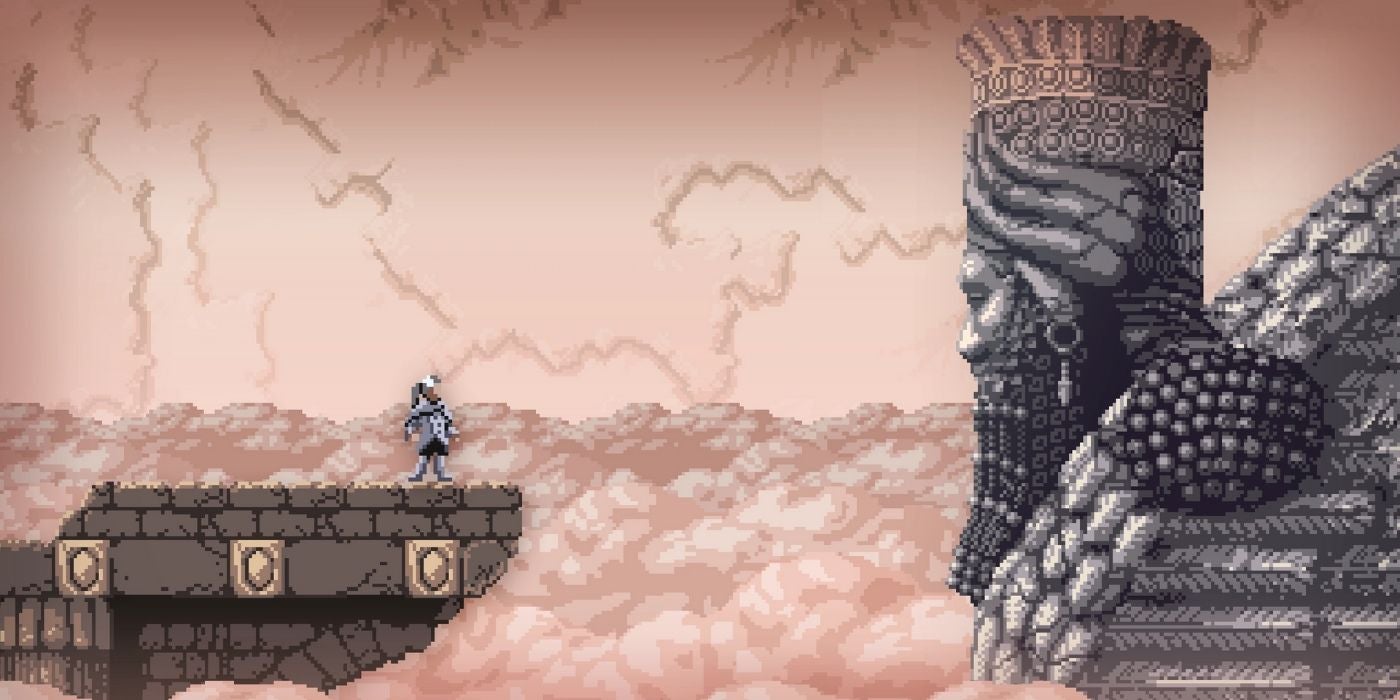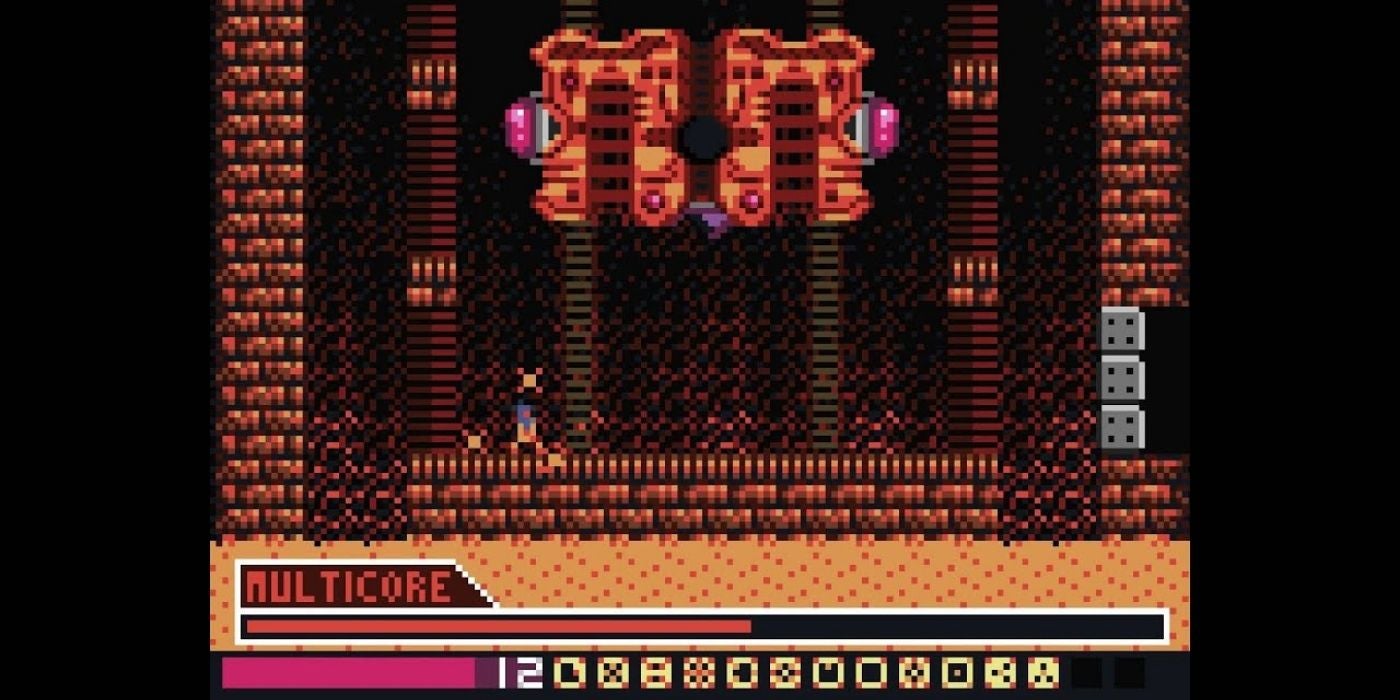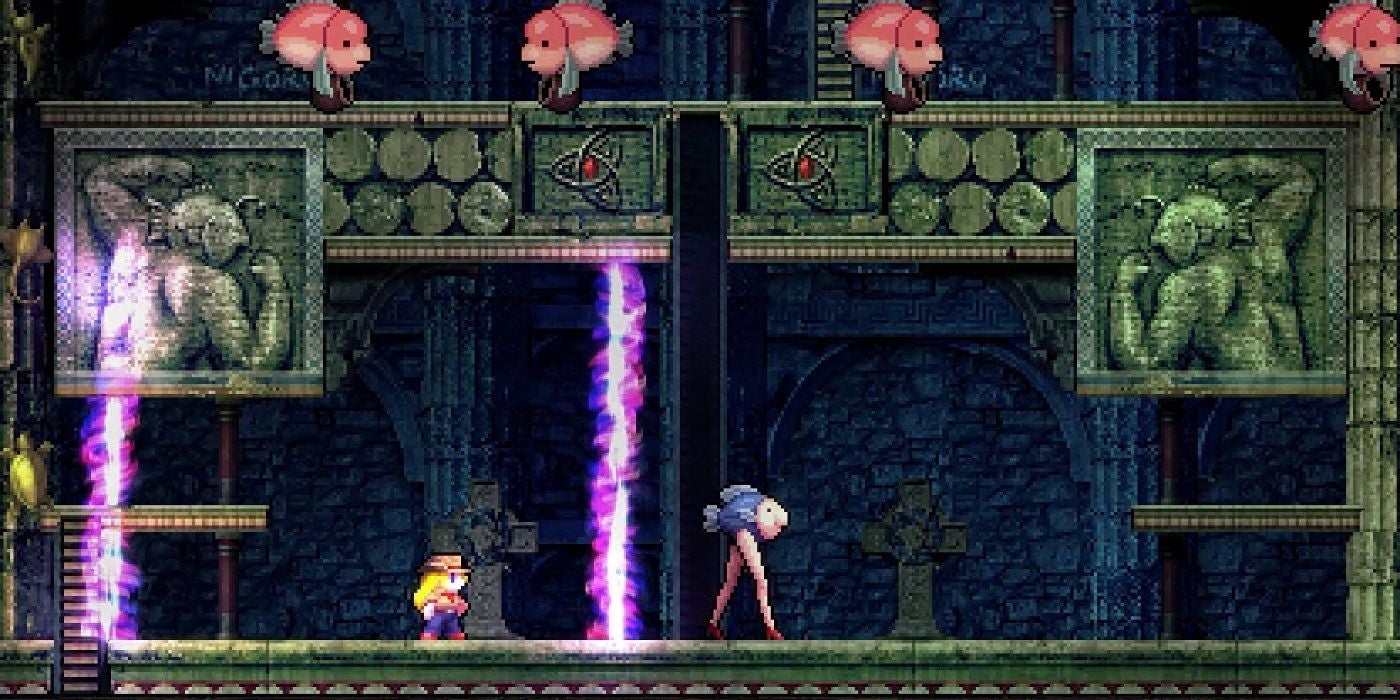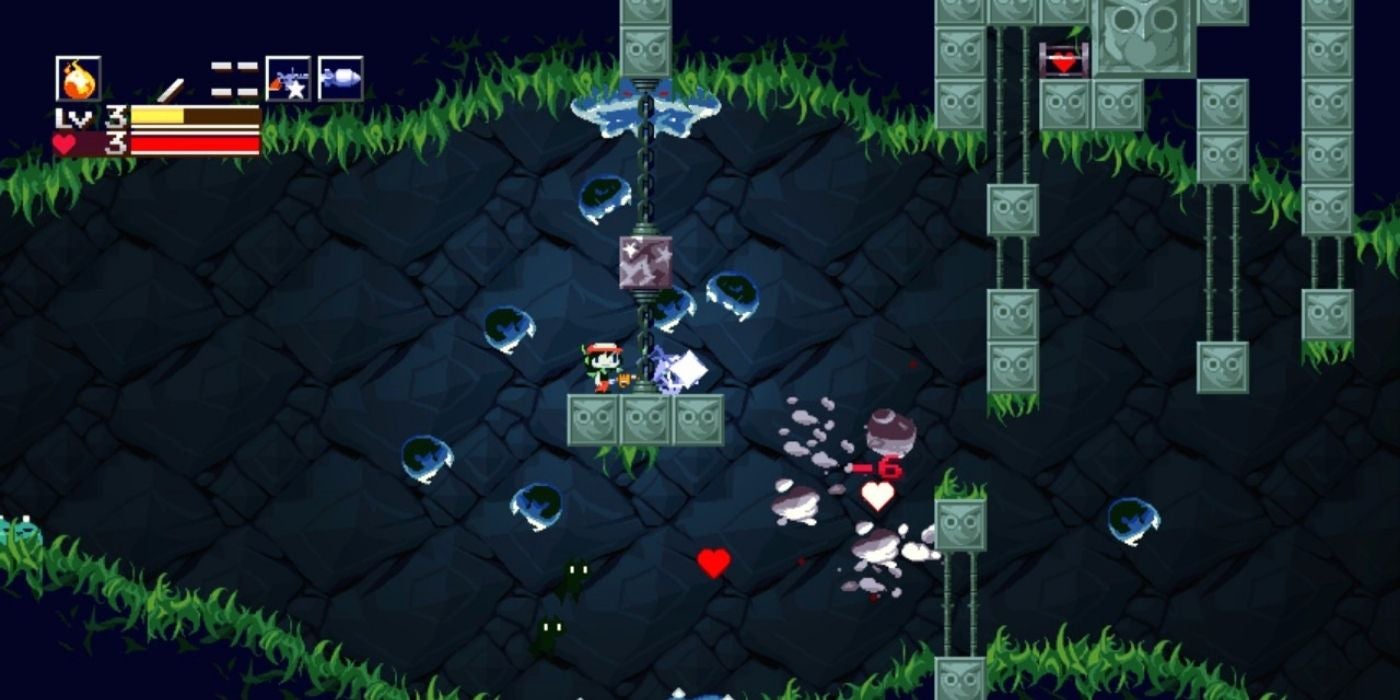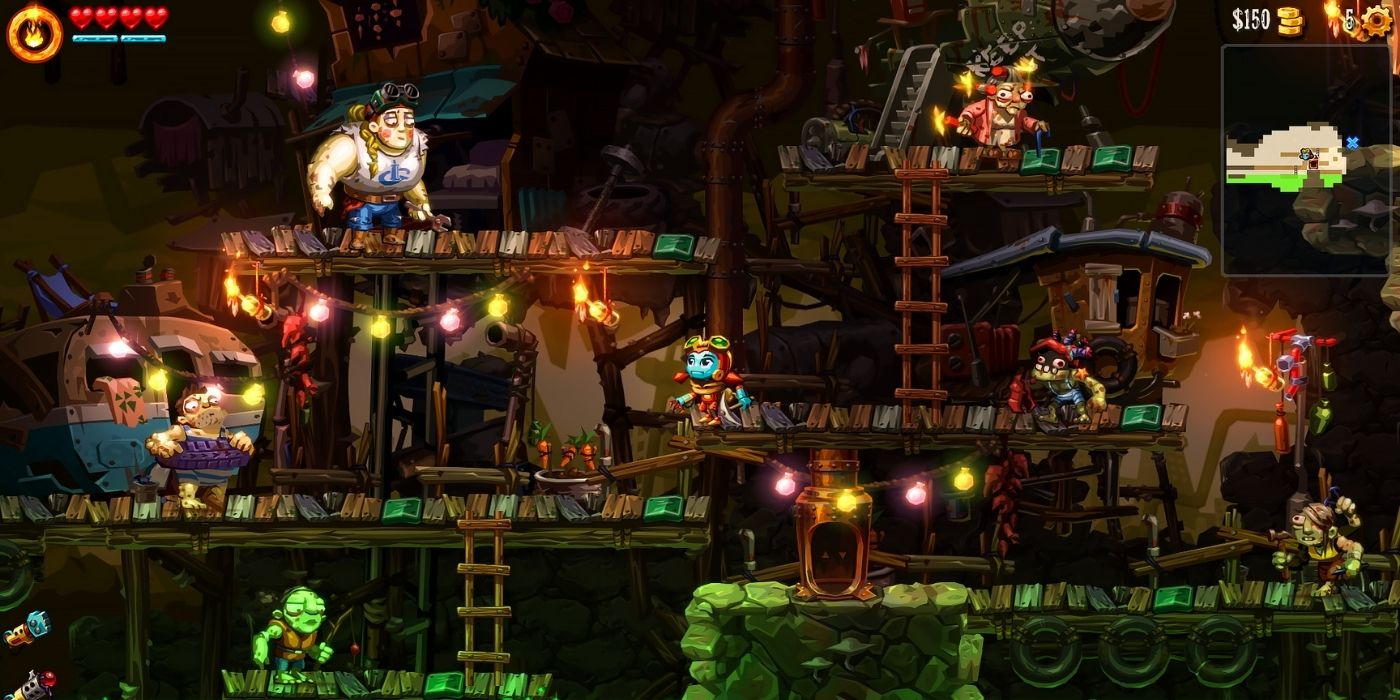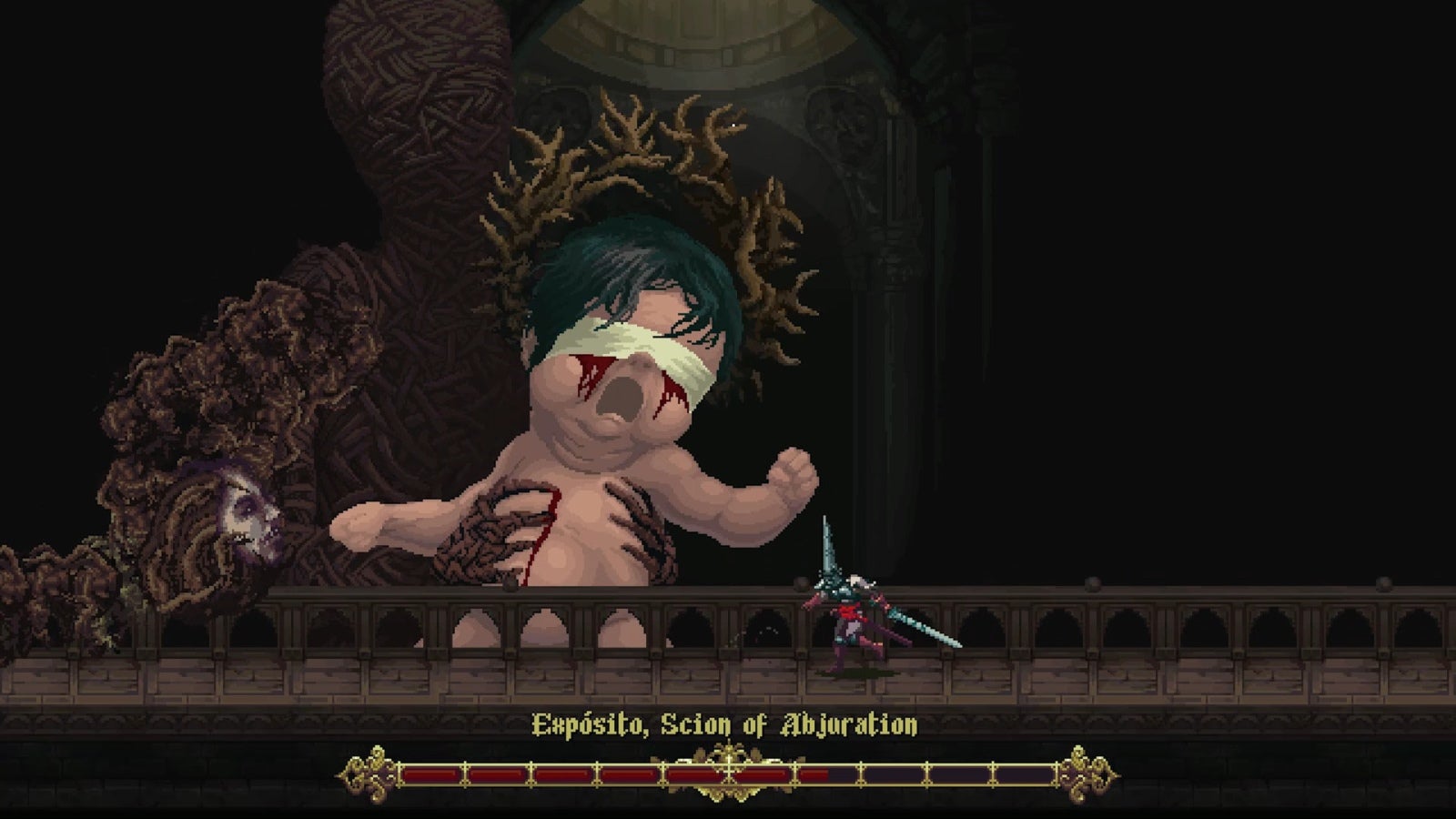It’s fair to say we’ve gone for a fairly conservative interpretation of the genre, sticking to games that represent the classic model of a large game world to explore, with areas unlocked and returned to as new abilities are gained. We’ve done our best not to conflate things too much with games that better fit into the ‘roguelike/lite’ category, nor indeed those that are better described as simply ‘platform games’. It’s a minefield, we tell you. And we’ve not yet unlocked the mine-dodging ability. So no, Dark Souls and its compatriots are not in here, and nor is Batman and his Arkham adventures. You disagree? You’re welcome to. Although by far the most controversial non-inclusion inside the RPS Treehouse is Dead Cells. Some passionately argue it’s a Metroidvania, others - correctly - point out that it’s a roguelite platformer, with a growing skillset. There were tears.
The best Metroidvania games
Guacamelee! Ori And The Blind Forest 1000 Amps Dust: An Elysian Tail Salt & Sanctuary Axiom Verge Owlboy Environmental Station Alpha La-Mulana AM2R Strider Cave Story+ Aquaria SteamWorld Dig 2 Hollow Knight Blasphemous
Guacamelee! Super Turbo Championship Edition
The Mexican-themed colour bonanza focuses on tactical 2D close-up fighting, adding in an array of moves that nudge on the edges of the beat-em-up genre. The recent announcement of a Guacamelee 2 is great news, because if anything else it means developers DrinkBox will have escaped their apparent loop of remaking the first one. First came Guacamelee!, then Guac Gold, and finally Super Turbo Championship Edition. That last one added new levels and abilities, and even four-player co-op. It’s still a little loose around the edges, a little scrappy, and the boss fights are often crazy difficulty spikes, but it’s spirit and verve make it stand out in an often very straight-faced genre. Where can I buy it: Steam, GOG, Humble.
Ori And The Blind Forest: Definitive Edition
One of the most sublime and perfectly executed metroidvanias, Ori & The Blind Forest emphasised exploration and achievement over difficulty on its original release, and in doing so rather divided the MV audience. It’s revised version, released a year later, improved and expanded the game with new areas, new abilities, and rather crucially, added difficulty levels, broadening the appeal of this most gorgeous and evocative of games. You play as Ori, a glowing woodland spirit, accompanied by a floating orb called Sein, who are attempting to discover why their world is being overtaken by a withering corruption. Which involves jumping, dashing, upgrading and fighting your way through an ever-growing collection of locations, each more astoundingly beautiful than the last. It stands out not just for the art and animation of James Benson (who went on to stun further in Firewatch), but also because of the complete perfection of its controls. Where can I buy it: Steam, GOG.
1000 Amps
If there’s a game on this list that you’ve never heard of, but need to play immediately, it’s 1000 Amps. The minimalist art belies a deeply complex and amazingly challenging room-based metroidvania. Each room begins in darkness, lit by manoeuvring your character to touch all the area’s lights. The more that are lit up, the higher you can jump in that room. And the more skills you’ve gained elsewhere in the game, the more able you’ll be to reach other lights when returning to areas, thus gaining access to previously impossible passageways. It could so easily have been developed as a straight puzzle game, a series of levels, and it would have been immensely satisfying. But it’s that the heavy puzzle focus is set in a metroidvania environment that makes 1000 Amps shine (fnarr) so brightly. It adds so much more, returning to older areas with newer skills, such as teleport, and reinventing how you approach them accordingly. As such, it’s inescapably an MV game, just with a far greater puzzle focus than might be normal for the genre. Most importantly, it’s brilliant. The mechanic of jump height being determined by the light in any given room, the way lights in a room will only stay lit if you’re able to get all of them without changing location, and the ever-expanding map with Metroid-style skill rooms, all adds up to make this something really special. Where can I buy it: Steam.
Dust: An Elysian Tail
Dust is about as hokey as it gets, from its gruesomely voiced saccharine characters, to merchants greeting you with lines like, “I’ve been expecting you,” and yet its combination of metroidvania design and combo-based side-scrolling combat has garnered an enormous fanbase. Because the truth is, if your game’s fun to play, you can excuse a flying orange fox/bat thing with a voice like fingernails down a blackboard. Just. Looking like a Disney animator lost his mind, Dust’s combination of fawny-eyed fauna and smashing up billions of 2D monsters with a tornado-inducing sword offers quite the striking palette. That’s thanks to the game’s having been developed almost entirely by illustrator Dean Dodrill. You play Dust, who is attempting to regain his memory while saving the land of Falana via the help of talking sword Ahrah… (Why are metroidvania plots always the same? And how did something that sounds like describing a fever dream become that “same”?) But this finds its glory in the ridiculously busy combat, as you lob out strings of combos to increase your firepower, and maximise the XP you’re gathering. New abilities, as you’d expect, let you access new areas. And old areas refill with all 409 billion enemies on each return, dispensed in a flurry of buttons. It’s definitely not the most difficult MV game you’ll find - in fact, the hardest part is sitting through the unskippable cutscenes, with all their accompanying screeched gibberish. But fortunately the levels between make it worthwhile. Where can I buy it: Steam, GOG, Humble.
Salt & Sanctuary
I think it’s fair to say that most of the games that get included in the “metroidvania” genre lean far more toward the Metroid half, than they do the Castlevania. That’s not the case for Salt & Sanctuary, although it’s a game that admittedly first gets compared to Dark Souls before anything else. What’s intriguing about Salt & Sanctuary is the super-tough castle-exploring combat game lifts and borrows so shamelessly from Dark Souls, but in making things 2D it feels as if it’s returning to From Software’s own inspirations. Castlevania is the source material for both, and while S&S is so overt in its DS referencing, this feels like some peculiar cousin of the two. Oddly enough, this is a far more appealing game to those who approach it without a Dark Souls background, since the features it’s so frequently observed to be nicking - returning to your death point to retrieve XP, weight-based equipment stats, fighting based on a stamina pool, etc - are actually familiar from many games long before. If anything, the millstone is it’s doing all these things without giving you a map, which is what makes it feel so distinct from the rest of the Metroidvania pool, and so overtly DS. But honestly, forget all the comparisons, don’t let yourself get bogged down in worrying what’s from where, and just enjoy that this is a rather splendid 2D open brawler, with some properly tough boss fights along the way. Where can I buy it: Steam, Humble.
Axiom Verge
There are an awful lot of Metroid clones, especially those made with pixel graphics reminiscent of the early Nintendo releases, that are terrible. And an awful lot of them seem a lot more terrible than they are because they make the mistake of so closely trying to resemble the Mother Game, and thus invite direct comparisons. It’s a foolish approach, a guaranteed way to ensure your game is looked upon unfavourably, when forcing the association with the best of the best. Then again, Axiom Verge is bloody brilliant. If anything, Axiom pushes its luck by going even more minimal than a SNES-era Metroid, and yet emerges unscathed. While in many ways a tribute, it’s also very much its own thing, packed with plenty of its own ideas, and most of all, a grappling hook. And was all the work of a lone developer. After an accident in what looks like a Small Hadron Collider, scientist Trace finds himself in a peculiar monochrome series of passages and chambers, filled with scratchy enemies, and armed with a gun whose most useful parts are scattered all over the place. Then you’re in for a familiar festival of exploration, gated by the gear you’ve yet to discover. The neatest unique feature is the way the game occasionally bars progress via blinking, gruesome glitches, a superb nod to the era it represents, which later can be fixed via a found tool. Oh, and there’s a coat that lets you teleport through walls. Axiom Verge boldly invites direct comparison with Metroid, and survives it. No, it’s not as good. But it’s astoundingly close. Creator Thomas Happ has recently created and released Axiom Verge 2, as well, if one iteration didn’t satiate your palette. It is an Epic store exclusive for now, though. Where can I buy it: Steam, Humble.
Owlboy
After so, so many years of delays, Owlboy finally appeared and did something very important: be lovely. It’s funny, smart, sad and novel, and all of these aspects are infused with loveliness. That may sound twee, and perhaps it is, but it’s a special treat in gaming land. It’s subtle too. From its opening tutorial sequence that serves to calmly undermine you, make you feel less good at the game than before you’d even started, it’s got quiet things to say. But it’s very funny as well, a sense of humour similar to the stunning Mario & Luigi handheld games. Also, good Lord it packs an emotional punch. There was a moment in the game that when you meet it, you’ll be compelled to find someone else who’s played to discuss it with them. It’s superbly crafted, the deftness in design so strong that you don’t notice it until you realise how it didn’t make mistakes in hindsight, and it’s just, well, completely lovely. Where can I buy it: Steam, GOG, Humble.
Environmental Station Alpha
Environmental Station Alpha takes the low-fi Metroid tribute to a whole new level, reducing itself to a minimal number of pixels, while still generating a superbly entertaining game. Although, perhaps problematically, one that it doesn’t sustain to the end. At the time of reviewing we raised the question, if you have a great time with a game for many hours, and then later find you don’t enjoy it any more, is it a game to recommend? How important is it that it remain great throughout, or can you say, “Hey, you’ll have a blast for a good long while, until you don’t any more.” ESA makes for the most interesting case, because it’s just so extremely good, until it isn’t. This is an MV game where the movement is utterly perfect, the boss balancing fantastic, and the level design - so important for the genre - highly refined. And then comes a moment where progression requires you make a significant change to the whole game, and it slams you hard into a difficulty wall, becoming a fiddly mess of frustrating combat and busywork. That first third is so splendid, so absolutely shining, that it still gets a recommendation from us. And for the super hardcore, the latter stages will be a welcome moment. Where can I buy it: Steam, Humble.
La-Mulana
Adam was already describing games as “Dark Souls but…” in 2012. You’ve got to give him credit for being ahead of the curve. La-Mulana, a favourite of his, was described as, “Dark Souls as a retro platform game, requiring thought and care, and punishing the over-confident.” It’s original 2005 Japanese release was a tribute to MSX games, the Japanese home console that preceded Nintendo. It was then remade as a 16-bit tribute game for the Wii, and eventually reached the PC in 2012. Where it stands out most is in its trust of the player. The Indiana Jones style disguises an incredibly difficult game, in which if you’re to stand any chance of success, you’re going to need to be taking notes and drawing maps as you go. It’s a game in which every detail is there for a reason, and if you rush forward, you’ll miss vital details and inevitably get stuck. But it trusts you to do better, to pay attention, to notice the signs along the way - something that can incredibly rarely be said of gaming. Where can I buy it: Steam, GOG, Humble.
Strider
Strider began life as an arcade game in 1989, subsequently ported across to home consoles and computers, before the previously definitive Mega Drive/Genesis port by Sega in 1990. An effortlessly hectic and violent side-scrolling platform game, brightly lit by Strider Hiryu’s manic attacks and gymnastic leaping. After a failed attempt to reboot it in 2009, scuppered by the bankruptcy of developers Grin, Capcom finally saw it remade by Double Helix in 2014. In the process of remaking, they incorporated all of the skills Hiryu had gained in both the original Strider and its sequel, as well has his cartwheeling leaps and bounds, but implemented a skills-based progression system that sees the game fall firmly in our Metroidvania boundaries. Oddly enough, it’s apparently the very mediocre Shadow Complex that inspired this - a game that doesn’t find a place on this list. But boy is Strider on there. It’s astonishing. So fast, so busy, and so good. Swishy ludicrous arcade fun, replete with all the coloured gates you could ever hope for to come back for later. Where can I buy it: Steam, Humble.
Cave Story+
A grand passion project by self-taught developer Daisuke ‘Pixel’ Amaya, Cave story shares a few aspects with classic Metroid designs, most notably a handful of key items providing access to new areas, but its strengths lie outside the familiar template. Intuitively weighty character movement, satisfying combat (especially the bosses), a fantastic soundtrack and a simple story well told enough that you’ll be hard pressed not to feel for the plight of the adorable rabbit-like Mimiga tribe, friendly denizens of an otherwise hostile land. There are some notable rewards for exploration and experimentation. Very few see it on their first playthrough, but those brave enough to dig deep and uncover the true final level - the Blood Stained Sanctuary - will find themselves left with an almost indelible memory; An escalation to near-Super Meat Boy levels of challenge, more fantastic music, a final plot twist and a spectacular boss all culminating in an ending that delivers catharsis in proportion to the pain endured to reach it. While the PC version of the game is no longer the greatest iteration of the game (the crown has passed to the graphically upgraded Switch version), Nicalis’ Cave Story+ remains one of the better ways to experience this originally freeware gem, even if many still lament the loss of ‘Huzzah!’ from the original, unofficial localization. Where can I buy it: Steam, Humble.
Aquaria
It seems almost quaint now that the Seumas McNally Grand Prize at the IGF awards should have gone to such a quietly beautiful game like Aquaria. But thank goodness it did. Aquaria’s subtle mix of standard Metroidvania exploration, and a spellbinding spell system based around singing, created something genuinely special. When you look at the names behind it, you can see why, in retrospect. Derek Yu, who would go on to become Mr Spelunky, and Alec Holowka, who co-created 2017’s astounding Night In The Woods. The two minds combined meant the unassuming-looking Aquaria belied a depth and power that few who have tried to copy the game since have come close to. Set entirely underwater, it means for once jumping isn’t a core aspect of the MV. Your character - Naija - sings in colours, to interact with the underwater life, and to cast spells, rather than directly interacting with game objects and enemies. The result is a hauntingly scored and surprisingly lonely game, that feels both serene and melancholy, in all the right ways. Where can I buy it: Steam, GOG.
Steamworld Dig 2
SteamWorld Dig was something unusual: a new approach to a metroidvania concept. In fact, it was many things to many genres, including part platform game, part RPG, and very cleverly tapping into 2013’s peak for mining games. Combining all these ideas, with its initial launch on the desperately-in-need-of-something-like-this 3DS, its gorgeous little tale told of a desert mining community of robots living on a post-apocalyptic Earth. You played Rusty, and your goal was to dig, mine for jewels, bop enemies, and explore an extraordinarily long way down into the planet’s rocky underneaths. The more you mined, the more new equipment you could buy and improve, the more areas you could access. But crucially, it wasn’t a 2D Minecraft of aimless digging - it was a plotted tale, with set goals along your improvised routes down, with a careful arc of gadgetry and talents that meant everything unfurled in a distinctively metroidvaniary way. This isn’t that game. This is 2017’s SteamWorld Dig 2, and we’ve picked its more recent sequel not because it’s dramatically different, but rather it’s an even more refined and smooth execution of the same concept. This time you’re playing as Dorothy, an NPC in the original game, exploring under a new town in search of the missing Rusty. And knowing what it’s doing, it gets on with SteamWorld Dig’s best bits much more immediately, with more interesting platforming, and a greater focus on those metroidvania elements. And a hookshot. Steamworld Dig 2 isn’t a difficult game - it’s very family friendly in all aspects. And in being so, it very usefully demonstrates that metroidvanias are not nearly as dependent upon their boss fights and challenges as one might think. This is a game that wants you to finish it, and to have an enormous amount of fun doing so. Where can I buy it: Steam, GOG, Humble.
Hollow Knight
Hollow Knight is a great time. A modern, 2D adventure, it brings all the classic Metroidvania concepts up to date in a fresh, new way, adding a touch of Dark Souls to the mix with its foreboding bosses and rock-hard combat. Players take on the role of an unknown, nameless knight, armed with just a small, but deadly nail to fight their way through the world. Many a menacing bug will cross your path, but you’ll reap ample rewards for vanquishing them. Spells and abilities will bolster your fighting style as you traverse the stage of Hallownest, and its vast open-world encourages you to explore every last nook and cranny. The story is also brought to life with its dark but delightful art style and animation, a robust cast of characters, and its gorgeous orchestral soundtrack really accentuates its melancholy atmosphere. Developers Team Cherry doesn’t stop there, either, as every aspect of Hollow Knight has buckets of detailed secrets to uncover, and sidequests aplenty to sink your teeth into. It’s a stunning game considering the size of the development team, and absolutely essential for Metroidvania fans. Where can I buy it: Steam, GOG, Humble.
Blasphemous
Blasphemous is a brutal platformer that takes place in the nigh on hellish world of Cvstodia, where The Penitent One (that’s you) must explore and execute enemies after becoming the sole survivor of a terrible ordeal. Your quest is simple: end the eternal damnation. Simple, right? Through waves of combat, the knight shall fight with their sword, Mea Culpa, at their side. The skillful combat compliments the punishing setting and adds to the sense of urgency within the game. Blasphemous has solidified itself as a must-play game ever since it came out: the satisfying but brutal combat, glorious art style and even the soundtrack all come together to create a grand experience. Where can I buy it: Steam, GOG, Humble.


